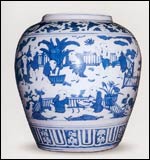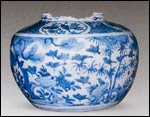| With
the passage of time, people's view on collection changed accordingly.
In former days, collectors thought it scorn to pack off official ware
ceramics made in late Qing dynasty which occupy a sizeable proportion
in the bidding block nowadays. Destroyed by nature and human being,
antique became less than before, especially those fragile ones. Most
of them faded away with time while only a little proportion still
exist now but fragmentary. These years such cracked ceramics manifest
a tendency of increment which means that collectors become more rational
than ever. The notion held by collectors that even the porcelain were
destroyed just a little, they will become devalued is outdated and
disappeared gradually. Although those ceramics are fragmentary, they
do not lose their beauty and value just like that with Venus. I have
two blue and white jars and I'd like to share them with you.
1.Jar with
design of kids' larkishness in underglaze blue
During Jiajing period of Ming dynasty, ceramic industry developed
step by step in China. At that time, official ware ceramics were
not only fired in the kiln used for emperor, some of them were fired
in the folk kiln. This blue and white jar is forty centimeters'
high. Its caliber is 20.5 centimeter and the bottom diameter is
39 centimeter. It has straight mouth, flat but slightly sunken bottom.
Besides, it is fully glazed. The veins on the jar have three levels:
on its shoulder, you can see typical cloud and crane pattern of
Jiajing period. On its central part, the pictures are about eighteen
boys who are curveting. They have different gestures and poses.
On the latter part, you will see particular design of petals of
the lotus in Jiajing and Wanli period. From its mouth to the bottom,
the jar cracks into two parts which are connected by adhibitting.
The body of the jar appears tough, thick and heavy. The surface
of the glaze is blue and does not have luster. The color of blue
and white on the jar appears a little bit purple, but looks grey
in general. Such characteristics are almost the same as those of
the ceramics in Jiajing period. What is more, the clothes the boys
wore just manifested some vivid characteristics of that time.
2.
Jar with design of trees and birds in underglaze blue
During Wanli period, there are two stages in the production of
ceramics in the official ware. In the first 35 years of Wanli period,
official ware plays an important role while after that time folk
kiln developed rapidly.
The mouth and the neck of the jar were destroyed seriously. It
is 18.5 centimeters' high. Its caliber is 13 centimeters and the
foot diameter is 18 centimeters. The jar is oblate; it has broad
shoulder and shallow ring foot. The surface of its glaze is blue
and lustrous. The veins on the jar also have three levels: on its
neck, curl grass will be seen; on its shoulder, there are four reserved
panels foiled by design on tapestry-like ground. In each of the
reserved panel, you will see birds, pine trees and bamboos. They
have various gestures and manifested lively scenery in Wanli period.
The most estimable aspects of this jar are as follow: first of
all, it has particular shape; it is short but not clumsy. Secondly,
jars with such veins are rare. Finally, the theme of the veins is
about trees and birds that manifested the artistic characteristics
during Wanli period. Such traits greatly affected the ceramics produced
later.
|

